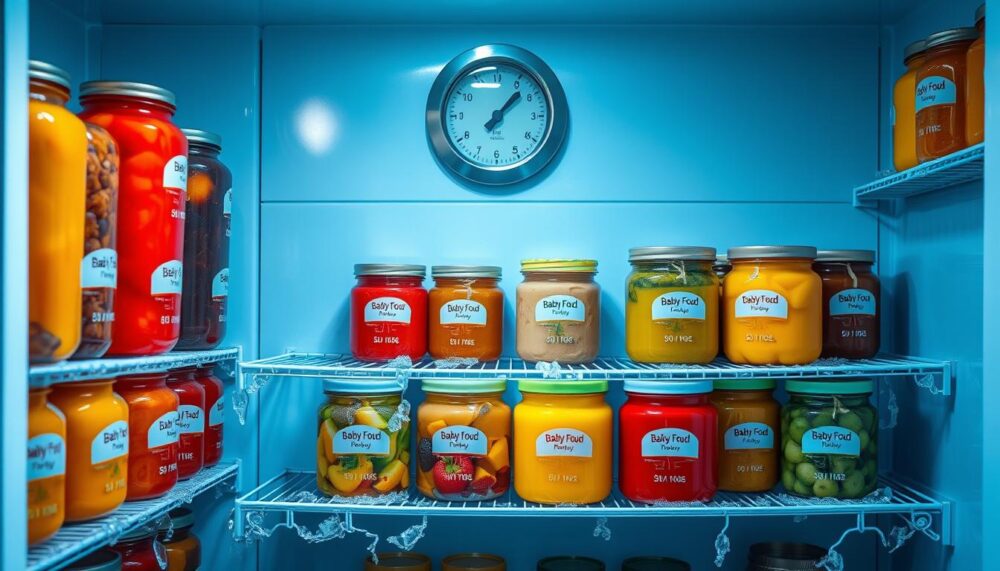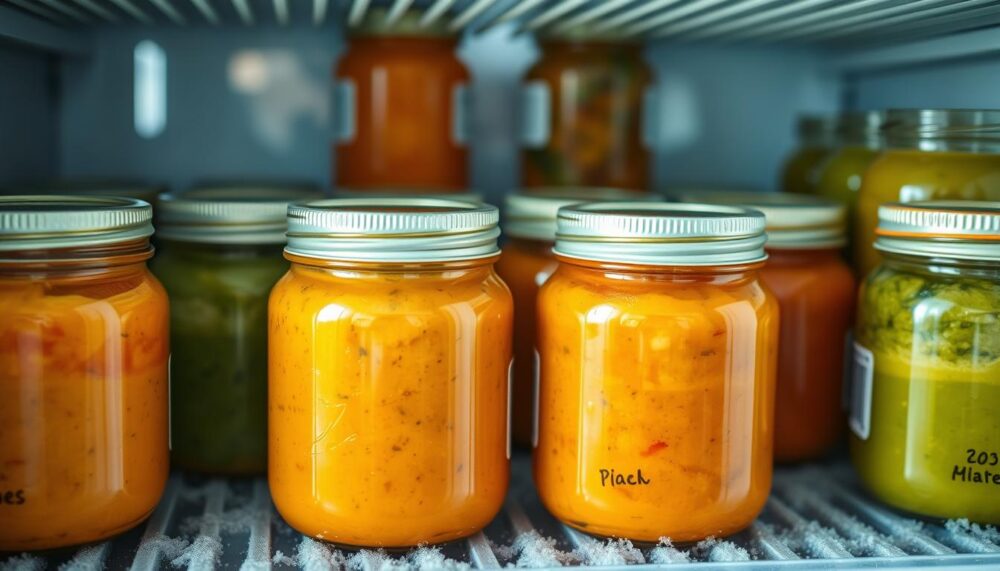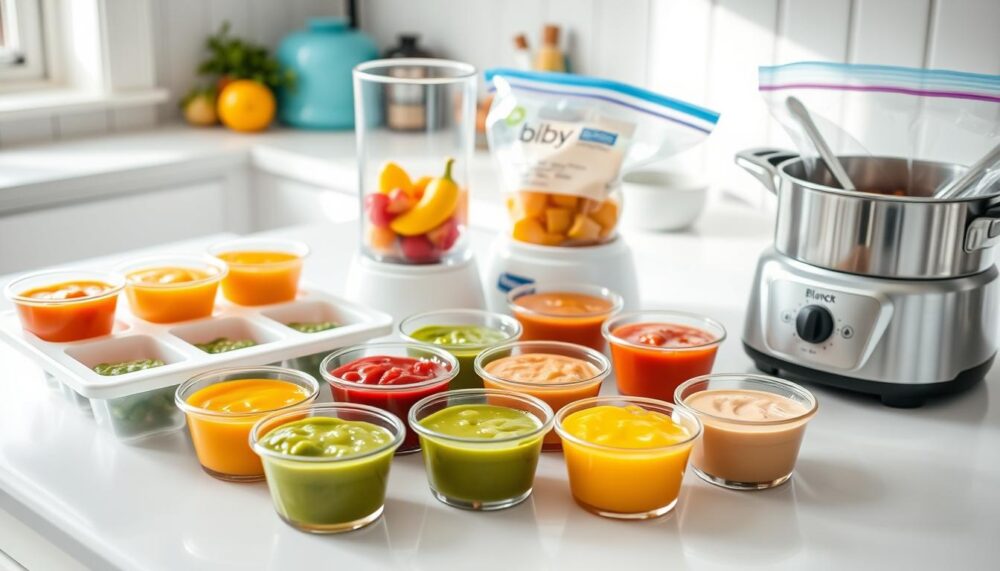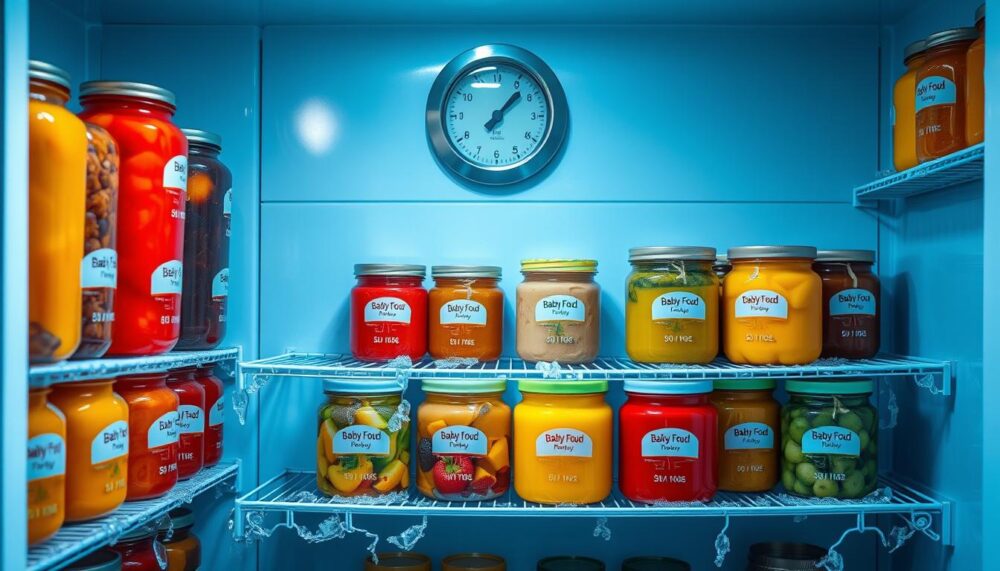
As a parent, you want the best for your baby. That includes nutritious and tasty meals. Freezing homemade baby food is a great way to keep it fresh and full of nutrients. But, do you know the best methods for freezing?
Ever thought, What’s the best way to freeze and store homemade baby food? This guide will share the top tips to make your kitchen a baby food haven. You’ll learn how to create and save healthy, tasty meals easily.

Key Takeaways
- Learn the benefits of freezing homemade baby food, including cost-effectiveness and preserving nutritional value.
- Discover the essential tools and containers needed for properly freezing baby food.
- Understand the safe food preparation and sanitization methods required before freezing.
- Get step-by-step guidance on how to freeze baby food correctly.
- Identify the best foods for freezing and which ones to avoid.
- Familiarize yourself with the proper storage duration and temperature requirements.
- Master the techniques for safely thawing and reheating frozen baby food.
The Benefits of Freezing Homemade Baby Food
Freezing homemade baby food is great for busy parents. It saves money and keeps nutrients fresh. This makes mealtime easier and healthier for your baby.
Cost-Effective Meal Planning
Freezing extra homemade baby food saves money. Cooking in bulk cuts down on daily prep time. It’s a smart move for families watching their budget.
Preserving Nutritional Value
Freezing your own baby food keeps nutrients intact. It locks in vitamins and minerals. This ensures your baby gets the most from their meals.
Time-Saving Benefits
Having frozen baby food is a big help for parents. It’s quick to thaw and serves as a healthy meal. This lets you spend more time on other important things.
“Freezing homemade baby food is a game-changer for parents. It’s a convenient, cost-effective way to ensure your child receives the best possible nutrition.”
Freezing homemade baby food offers many benefits. It’s good for your wallet and keeps meals nutritious. This simple step can greatly improve your child’s health and your daily life.
Essential Tools and Containers for Freezing Baby Food
Many parents find making homemade baby food and freezing it to be practical and cost-effective. But, picking the right containers is key to keep the food fresh and healthy. The National Health Service (NHS) in the UK suggests safe and easy-to-use storage options for freezing baby food.
Silicone freezer trays are a favorite among parents. They come in different shapes and sizes, making it simple to store individual portions. The BPA-free, flexible silicone is safe for freezing baby food in glass jars without worrying about breakage.
| Container Type | Pros | Cons |
|---|---|---|
| Silicone Freezer Trays | Portioned servings BPA-free Durable and flexible | Limited storage capacity May require additional covers |
| Glass Jars | Transparent for easy identification Reusable and sustainable NHS recommends freezing in glass | Potential for breakage Limited storage capacity |
| Plastic Containers | Stackable and space-saving Readily available | Potential for chemical leaching May stain or retain odors |
Following freezing baby food nhs guidelines is crucial. Use BPA-free and freezer-safe containers to keep the food safe and nutritious. By choosing the right storage, you can enjoy homemade baby food while keeping its nutritional value intact.

Safe Food Preparation Before Freezing
Keeping homemade baby food fresh and safe is crucial. Follow key steps like sanitizing, temperature control, and a food safety checklist. This ensures your baby’s meals stay healthy and free from bacteria.
Proper Sanitization Methods
Start by cleaning all tools, surfaces, and containers with hot, soapy water. Make sure to rinse well and let them dry. For extra safety, use a mild bleach solution and rinse off any leftover bleach. Keeping everything clean is vital when making homemade baby food.
Temperature Guidelines
After cleaning up, focus on the food. Cook ingredients to the right temperature with a food thermometer. Cool cooked food quickly to room temperature before freezing. This helps keep the food’s taste and texture. Remember, how long does homemade baby food last in the fridge is 3-4 days. Freeze any leftovers for longer storage.
Food Safety Checklist
- Wash hands thoroughly with soap and water before handling food
- Sanitize all utensils, work surfaces, and storage containers
- Cook all ingredients to the proper internal temperature
- Rapidly cool cooked foods to room temperature before freezing
- Label all frozen items with the contents and date
- Adhere to homemade baby food storage guidelines for maximum freshness
By sticking to these food safety tips, parents can be sure their homemade baby food is nutritious, tasty, and safe.

How to Freeze Baby Food: Step-by-Step Guide
Freezing baby food is a big help for busy parents. It saves time and money. Plus, it keeps the nutrients in homemade meals. Here’s how to freeze baby food the right way:
- Prepare the Food: First, wash, peel, and cook your ingredients. Then, puree or mash them until they’re right for your baby.
- Portion the Food: Use ice cube trays or small containers to portion the food. This makes it easy to thaw and serve the right amount.
- Label and Date: Label each container with what’s inside and the date. This helps you keep track of what’s in your freezer and use the oldest first.
- Freeze the Food: Put the portioned food in the freezer, leaving space between containers for freezing.
- Freeze Store-Bought Baby Food: You can also freeze store-bought baby food. Just put it in airtight containers or bags and label them.
- Optimize Freezer Space: Arrange containers in your freezer to save space. Use stackable containers or vertical storage to stay organized.
Follow these steps to fill your freezer with nutritious, homemade baby food. It’s ready when your baby needs it.

“Freezing baby food is a game-changer for busy parents. It saves time, money, and helps preserve the nutritional value of homemade meals.”
Best Foods for Freezing and Foods to Avoid
Not all foods freeze the same when making homemade baby food. Some keep their texture and nutrients well, while others don’t. Knowing which foods are best for freezing is key for your baby’s meals.
Freezer-Friendly Baby Foods
- Pureed fruits and vegetables, such as sweet potatoes, peas, and bananas
- Protein-rich foods like mashed chicken, turkey, or beans
- Whole grain cereals and porridges
- Homemade broths and soups
Foods That Don’t Freeze Well
Some foods don’t freeze well for baby food. These include:
- Dairy products like milk, yogurt, and cheese (they can separate or curdle when frozen)
- Eggs (they can become grainy or rubbery)
- Delicate greens like lettuce or spinach (they tend to wilt and lose texture)
- Oatmeal or porridge (they can become gummy or dry when frozen)
Special Considerations for Dairy-Based Foods
Dairy-based baby foods don’t freeze well. But, you can still use dairy by adding a little milk or yogurt to frozen purees when reheating. Just remember not to refreeze leftovers.
| Food Category | Freezer Storage Duration |
|---|---|
| Pureed Fruits and Vegetables | 2-3 months |
| Protein-Rich Foods | 2-3 months |
| Whole Grain Cereals and Porridges | 1-2 months |
| Homemade Broths and Soups | 2-3 months |
When freezing baby food with milk, add dairy after thawing and reheating. This keeps the food’s texture and nutrients good.
Storage Duration and Temperature Requirements
Keeping homemade baby food fresh and nutritious is key. Freezing baby food right is important for safety and keeping its quality. Knowing how long and at what temperature to store it is crucial.
The National Health Service (NHS) says you can freeze baby food for up to 6 months. But, the exact time depends on the food type. Let’s look at how long you should store different baby foods:
| Food Type | Recommended Freezer Storage Duration |
|---|---|
| Fruit purees | 2-3 months |
| Vegetable purees | 2-3 months |
| Meat-based dishes | 2-3 months |
| Combination dishes (e.g., casseroles, stews) | 2-3 months |
| Dairy-based foods (e.g., yogurt, cheese) | 1-2 months |
For safe and quality baby food, keep your freezer at 0°F (-18°C) or colder. Changes in temperature can harm the food, losing nutrients and risking bacteria growth.
By sticking to these storage and temperature tips, you can make homemade baby food. This way, you give your baby the best nutrition. Always mark your frozen food with the date and what’s inside to keep it fresh.

Safe Thawing Methods and Reheating Guidelines
It’s important to thaw and reheat frozen baby food safely. This keeps it nutritious and safe to eat. Let’s look at the best ways to how to safely thaw frozen baby food and reheat it.
Proper Thawing Techniques
Thawing frozen baby food slowly is key. Here are the best methods:
- Refrigerator Thawing: Put the frozen food in the fridge. It will thaw slowly over 24 to 48 hours, depending on size.
- Water Bath Thawing: Place the sealed container in cold water. Change the water every 30 minutes until thawed, usually 1-2 hours.
Reheating Safety Tips
When reheating thawed baby food, follow these safety tips:
- Use a clean spoon to move the food to a safe dish or pan.
- Heat in short, 15-second bursts, stirring often, until it’s 165°F.
- Don’t let it boil or overheat, as it can lose nutrients.
Signs of Spoilage
Watch for signs of spoilage in thawed frozen baby food. Look for:
- Unusual smells or colors
- Visible mold or bacteria
- Expired “use by” date
By using these safe thawing and reheating tips, you can give your baby nutritious, tasty frozen baby food. It stays safe and of high quality.
Common Mistakes to Avoid When Freezing Baby Food
Storing and handling homemade baby food right is key for your baby’s safety and health. Freezing is great for keeping meals fresh and nutritious. But, there are mistakes that can ruin the quality and safety of frozen food.
One big mistake is not cooling food enough before freezing. Putting warm or hot food in the freezer can cause bacteria to grow and ice crystals to form. This can mess up the food’s texture and taste. It’s important to let the food cool down completely before freezing.
- Don’t use the wrong containers for freezing, like plastic bags or unsuitable containers. They can cause freezer burn and let air in, making the food go bad faster.
- Don’t overfill containers. Leaving some space helps prevent spills and leaks when the food freezes.
- Not labeling and dating frozen food can make it hard to keep track of how long it’s been stored. This can lead to safety issues and waste.
By avoiding these mistakes and following the right homemade baby food storage guidelines, you can make sure your frozen baby food is safe. It will also keep its nutrients and taste.
| Common Mistake | Potential Consequences | Recommended Solution |
|---|---|---|
| Failing to cool food before freezing | Bacterial growth, ice crystal formation, and degraded texture/flavor | Allow food to cool completely before freezing |
| Using unsuitable containers | Freezer burn, air exposure, and reduced shelf life | Use freezer-safe containers designed for food storage |
| Overfilling containers | Spills, leaks, and potential food safety issues | Leave adequate headspace for expansion |
| Neglecting to label and date | Difficulty tracking storage duration and food safety | Clearly label and date all frozen food containers |
By avoiding these mistakes and following the best ways to freeze baby food, you can keep your homemade meals safe, healthy, and tasty for your baby.
Conclusion
As we finish our guide on homemade baby food, it’s clear that parents can keep their baby’s meals fresh and nutritious. By following the storage guidelines in this article, you can make sure your baby eats safe, healthy food. This food is always ready to go.
It’s important to follow food safety rules when freezing how to freeze baby food. Clean your surfaces well and keep an eye on the freezer temperature. Each step is key to keeping your baby healthy and happy. Use these tips in your meal planning to give your baby nutritious, homemade meals they’ll love.
Freezing homemade baby food storage guidelines can be a big help for busy parents. It saves time, money, and gives you peace of mind. With a little practice, you can make sure your baby eats the best homemade food.
FAQ
How do you preserve homemade baby food?
Freezing is a great way to keep homemade baby food fresh. Make sure to prepare, portion, and store it in airtight containers. This way, you can enjoy it for months in the freezer.
Is freezing food for baby safe?
Yes, freezing baby food is safe if you follow food safety rules. Use clean tools, cook and cool food right, and store it at the right temperature.
Can you freeze baby food with milk in it?
Freezing baby food with milk is okay, but avoid dairy like yogurt or custards. Their texture might change. Stick to non-dairy purees for better results.
How long does homemade baby food last in the fridge?
Homemade baby food stays fresh in the fridge for 3-4 days. For longer storage, freeze it in airtight containers or ice cube trays.
Can you freeze baby food in glass jars?
Yes, glass jars are fine for freezing baby food, but choose the right ones. Avoid regular glass jars that might break. Use tempered glass or mason jars that are freezer-safe.
Can you freeze store-bought baby food?
Yes, you can freeze store-bought baby food, but check the packaging. Some might not freeze as well as homemade purees. Always follow the manufacturer’s guidelines.
How long does homemade baby food last in the freezer?
Homemade baby food can last 2-3 months in the freezer if stored right. For the best taste and nutrition, use it within 1-2 months.
How to safely thaw frozen baby food?
To thaw frozen baby food safely, put it in the fridge overnight. Or, thaw it in a bowl of warm water, changing the water as needed. Never thaw at room temperature to avoid bacterial growth.
How to thaw frozen baby food?
The best way to thaw frozen baby food is to put it in the fridge overnight. You can also thaw it in a warm water bath, changing the water as needed. This method is safer than thawing at room temperature.
READ ALSO: Why Do Babies Sleep with Their Arms Up? Understanding Infant Sleep Positions